NASA Spotlite Challenge: Land Detectives
Developed in Collaboration with NASA Earth Science Education Collaborative
As NASA Land Detectives, you are challenged to gather and share evidence to confront misconceptions about Earth’s land cover. Land cover is what is on Earth’s surface, such as trees, grass, pavement, and buildings.
Land cover doesn't change.
The land cover of an area doesn't matter.
Misconception 1: Land cover doesn’t change
Human activity can change land cover.
Natural phenomena can change land cover.
Land cover can change slowly or quickly.
Misconception 2: The land cover of an area doesn’t matter.
Habitats are impacted by land cover.
Communities are impacted by land cover.
Land cover influences the water cycle.
Land cover influences temperature.
Go to the RESEARCH tab for suggested activities to gather data and make observations.
Be sure to film how you set up and run the activities to include as part of your Spotlite video.
What Is a NASA Spotlite?
These 90 to 120 second videos are written, filmed, edited, and produced by students using the engineering design process. Each video targets a science misconception.
Where Are NASA Spotlite Videos Used?
Approved videos that meet all criteria and constraints will be added to the NASA eClips website.
These videos will support science lessons and be used by classroom teachers across the United States.
Why Does NASA Want Videos?
One of NASA’s goals is to improve scientific literacy, or our understanding of science. The goal of the video is to change students' misconceptions about a topic in science.
How Can Spotlites Help?
A video that includes a demonstration and encourages others to try a related science activity can be used to help teach the correct science.
Who Can Participate?
This challenge is for students in grades 6 through 12. Students age 13 and older may appear on camera. Students under age 13 may still participate in all other aspects of the project.
Do You Need Special Equipment?
You don't need high tech recording and editing tools. All steps for creating a Spotlite video can be accomplished using cell phones, tablets, and laptops.
An Adobe Spark template is available for teams to create a NASA Spotlite video.
One free tool learners may use is Screencastify.
Components of a NASA Spotlite Video
Include the following components to develop a NASA Spotlite video that will help others confront their misconception about a science topic. Think of an appealing storyline to keep the target audience engaged throughout the video.
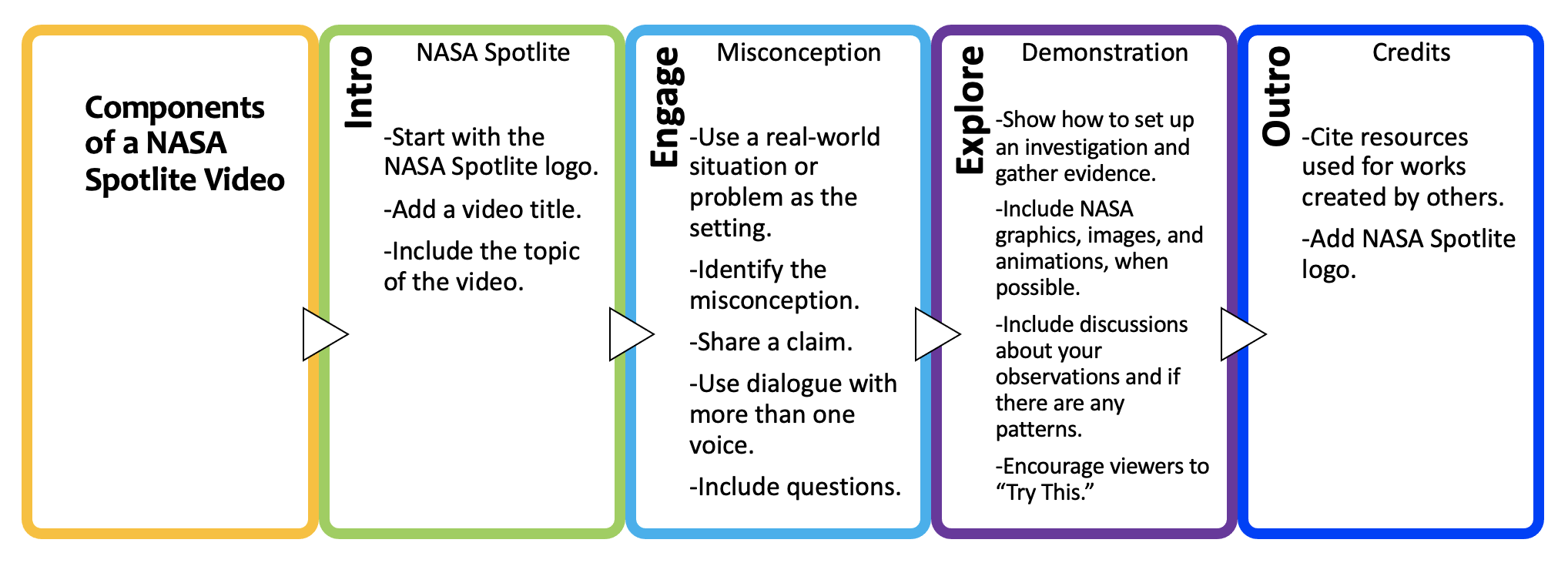
Criteria and Constraints
The video produced must:
-
Contain an Intro that includes the:
- NASA Spotlite logo
- video title
- topic of the video
-
Contain an Engage section that:
- uses a real-world situation or problem as the setting
- identifies the misconception
- shares a claim
- uses dialogue with more than one voice
- includes questions
-
Contain an Explore section that:
- shows your team doing an investigation, making observations, or gathering field notes
- shows your audience how to gather their own EVIDENCE
- includes NASA graphics, images, and animations, if possible
- includes appropriate safety statements (on screen and audio). Safety statements can be found under the Research tab
- includes discussions about patterns in your observations
- encourages viewers to “Try This”
- Be of high quality in visual content
- Be of high quality in audio aspects
- Be between 90 and 120 seconds in length
- Contain closed captioning.
The following statements should be included on the last frame of the video.
- Produced and edited by _________________
-
NASA Disclaimer Statement (required)
This material is based upon work supported by the National Aeronautics and Space Administration under award No. NNX16AB91A. Any opinions, findings, and conclusions or recommendations expressed are those of the author(s) and do not necessarily reflect the views of the National Aeronautics and Space Administration (NASA).
-
NASA Resources Credit
If you used NASA for graphics, images, and/or animations please include a credit or statement such as:
Graphics presented in this video were developed by the National Aeronautics and Space Administration.
You may also find a suggested credit on the original NASA source. -
Credits for other Resources
If you used other graphics, please cite the source:
Photographer, F.M. (Photographer). (Year, Month Date of Publication). Title of Photograph [digital image]. Retrieved from URL. - Include the Spotlite Logo
Misconception 1: Land cover doesn’t change.
- Claim 1: Human activity can change land cover.
- Claim 2: Natural phenomena can change land cover.
- Claim 3: Land cover can change slowly or quickly.
Demonstration and Experimentation Ideas
GLOBE and GLOBE Observer Resources
Demonstrations, Activities, Simulations, Data Analysis
Science Information Links
Misconception 2: The land cover of an area doesn’t matter.
- Claim 1: Habitats are impacted by land cover.
- Claim 2: Communities are impacted by land cover.
- Claim 3: Land cover influences the water cycle.
- Claim 4: Land cover influences temperature.
Demonstration and Experimentation Ideas
GLOBE and GLOBE Observer Resources
Demonstrations, Activities, Simulations, Data Analysis
NASA cares about the safety of all learners!
- Prior to observing, visually scan the area being observed for any potential hazards.
- Always remain stationary while entering data into the GLOBE Observer app.
Tips for Script Writing and Filming
2-Column Scripts
Write a 2-column script for your video. In the left-hand column of a two-column script you should include the visual aspects of the production. Here is where the content of each shot is identified. Use abbreviations to describe the type of shot, such as "CU" for "close-up," "MS" for "medium shot," and "WS" for "wide shot." Note any special effects in this column. Use “GFX” for graphic or image. Voice-over (“V.O.”) is used when someone is speaking while an image or animation is on screen.
The right-hand column contains the audio portions of the production. Write the dialogue, sound effects and music in this column.
The content of the columns should be synchronized, so that the dialogue in the right column matches the shots in the left column.
Storyboards
The purpose of a storyboard is to plan how the video will unfold shot-by-shot. Here are some tips for designing a storyboard.
- Establish a timeline for the events in the video.
- Identify the scenes that will be needed to tell the story.
- Think about some key elements you want to include.
- Audio
- Graphics
- Text
- Add relevant characters to each cell in the storyboard.
- Include the important statements the character or narrator needs to say to address the science misconception.
Consider these questions:
- What is the setting/background for the scene? (Be sure your setting is not cluttered as this will distract from the video.)
- What actions are the characters performing?
- What props are in the scene?
- What is the size, color, and position of the text on screen?
Filming
Prior to filming, read the rubric that will be used to evaluate the video. The elements listed in the rubric should be used to guide your production of an effective video that addresses a science misconception.
Video Editing
Adding Closed Captioning
How To Add Closed Captions And Subtitles To Your YouTube Videos
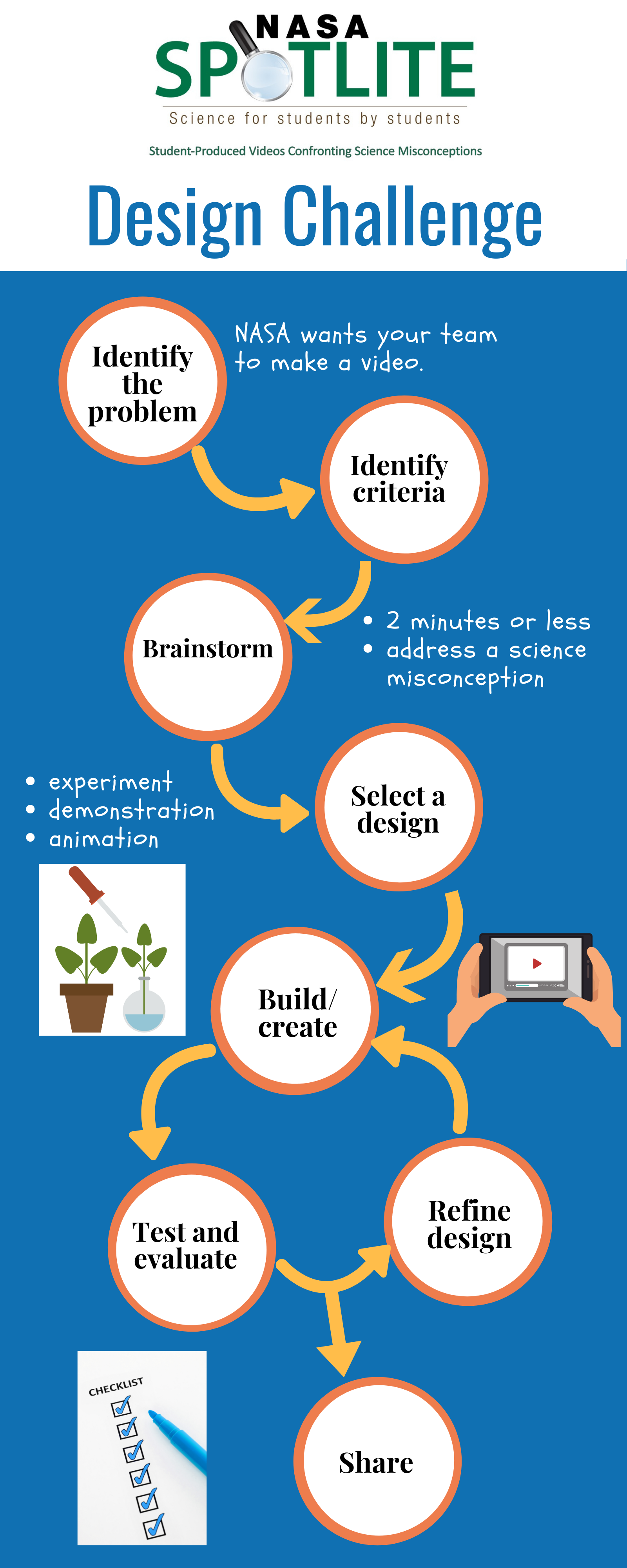
Design Challenge Statement
NASA Spotlite Challenge: Land Detectives
Student Scientists and Production Teams Needed!
Gather your team, your observations, your creativity, and video recording devices.
The National Aeronautics and Space Administration (NASA) wants you and your team to produce a video for the NASA eClips website.
Your video must engage, entertain, and encourage other learners to gather and analyze data that can be used to confront misconceptions about land coverings.
Identify the Problem
| Problem Board | ||
|---|---|---|
| What do we need to know and do? | What do we already know? | What do we need to learn and where do we find it? |
Brainstorm
Think of an interesting way to state the misconception and explain why it is wrong.
- Brainstorm possible engaging storylines for the targeted audience.
- Where will the story take place?
-
What characters will be in the story?
- One character has the wrong information.
- Another character notices that something is wrong and makes a CLAIM.
Create
Visual
|
Audio
|
|
|---|---|---|
|
Beginning Present the question to address the misconception through a real-world problem.(30 seconds) |
||
| Middle Show how to set up demonstrations and investigations to explore the CLAIM.(60 seconds) |
||
| End Challenge the audience to try the demonstrations.(10-30 seconds) |
Evaluate - Peer Review
Share your script and storyboard with another team and science expert.
Film and Edit
- Prepare the setting.
- Make sure there is enough light.
- Speak loudly and clearly into the microphone.
- Make sure graphics and images are appropriate for the video.
- Have an adult check your work.
- Product logos cannot appear in your video. NASA does not promote or endorse commercial products.
- To protect the privacy of children, faces of students under the age of 13 will not be published on the NASA eClips website.
- Everyone appearing in the video must sign a media release form.
| Video Production Rubric | |
|---|---|
| The video produced: | Exemplary |
| Contains an ENGAGE section that identifies the science misconception. | Presents the question to address the misconception through a real-world problem. Makes a CLAIM that refutes or disproves the misconception. |
| Contains an EXPLORE section that includes a demonstration to debunk the misconception. | Through the demonstration the viewer sees how to set up an activity to explore the science concept and collect EVIDENCE. |
| Keeps the viewers’ attention and is engaging. | Highly engaging through the entire video. Viewer is engaged with questions to answer or instructions to follow. Use dialogue with more than one voice (conversation). |
| Contains high quality visual content. | The visual content is of high quality. Clear and crisp images/clips are used throughout the video. |
| Contains high quality audio aspects. | The audio is of high quality and is used throughout the video. Audio level is consistent throughout the video. |
| Ranges between 90 and 120 seconds. | Falls within the time limit constraints. |
| Captures the speakers pronouncing words with clarity and appropriate inflection/expression. | All speakers speak clearly and distinctly, facial expressions and body language generate a strong interest and enthusiasm. |
| Includes labels for ENGAGE and EXPLORE sections, Spotlite intro, end credits, NASA disclaimer, and Spotlite outro. | Video includes all required components with no errors. |

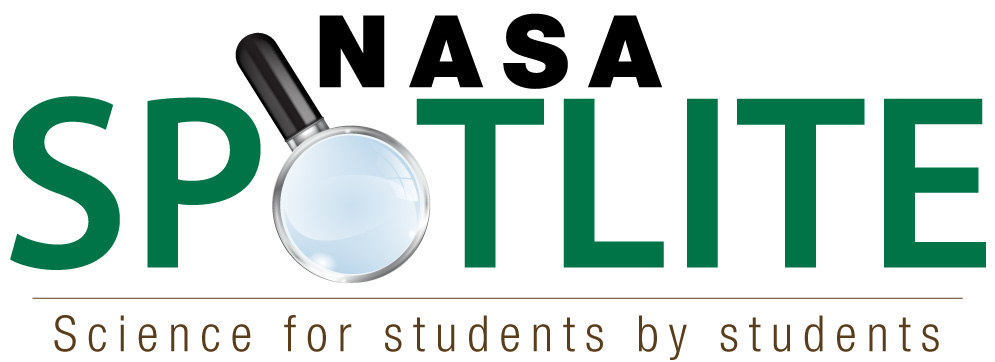

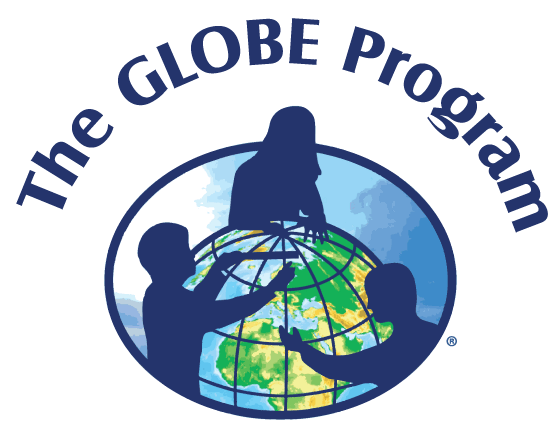

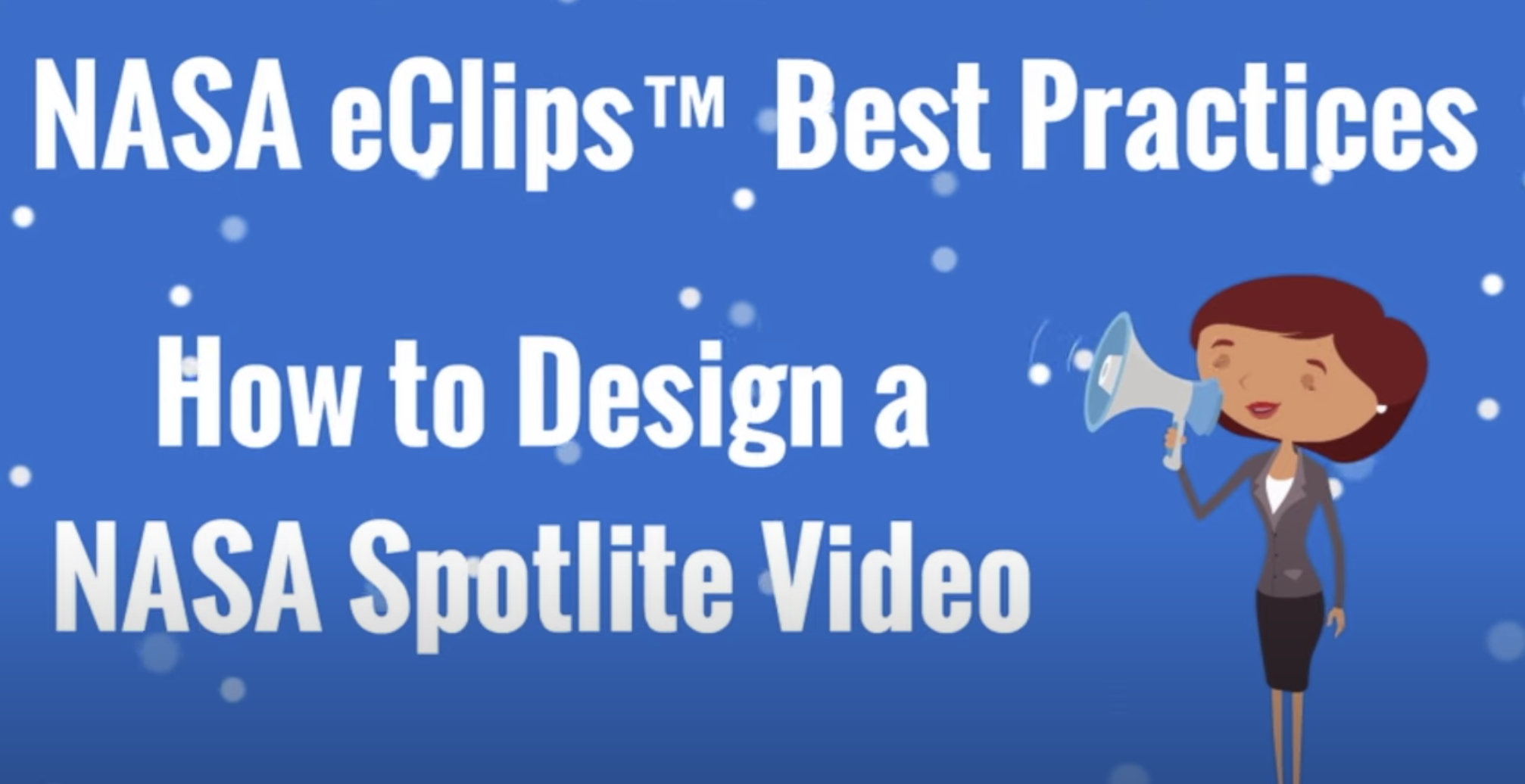
 Recent tweets from NASA eClips
Recent tweets from NASA eClips

